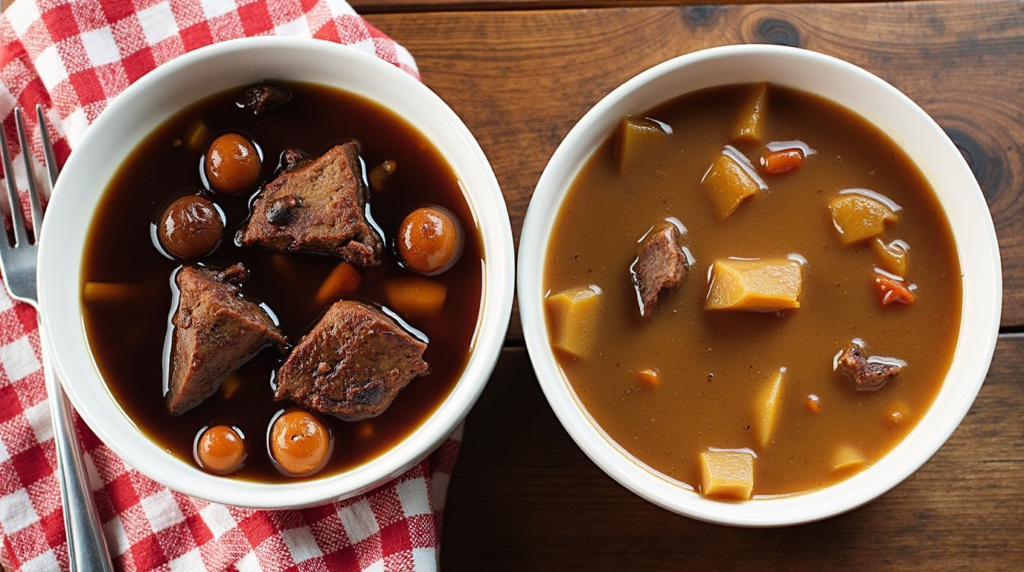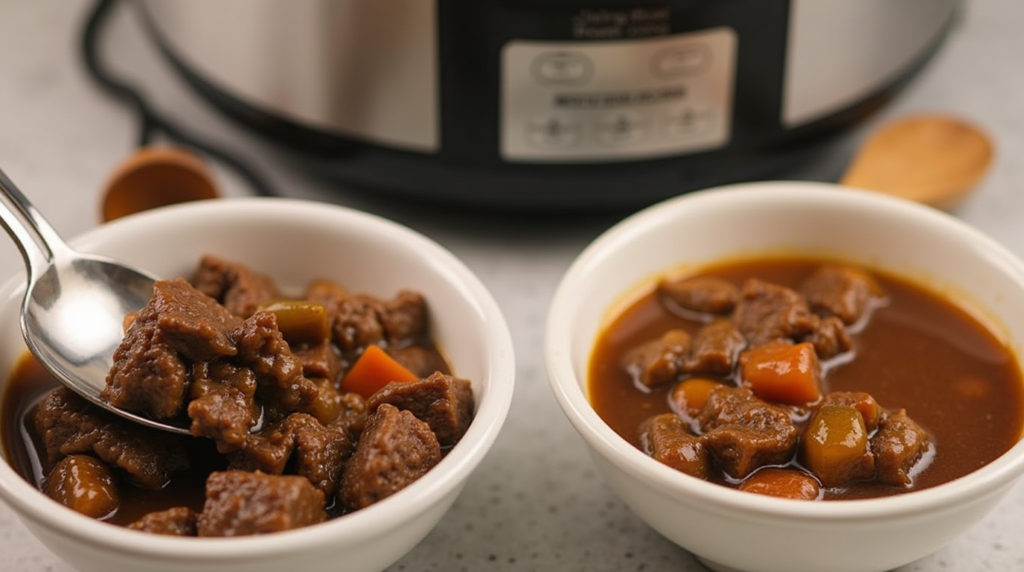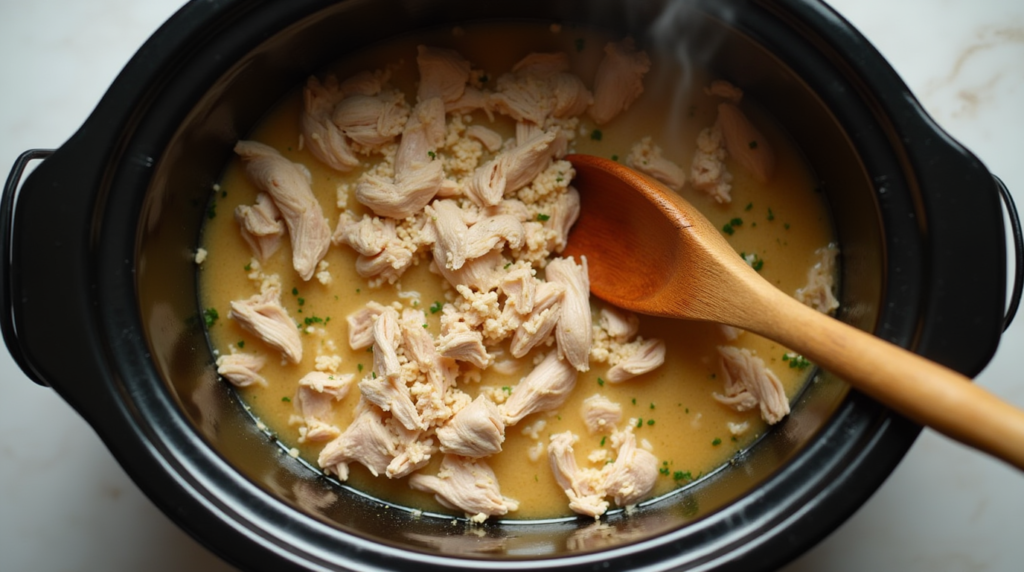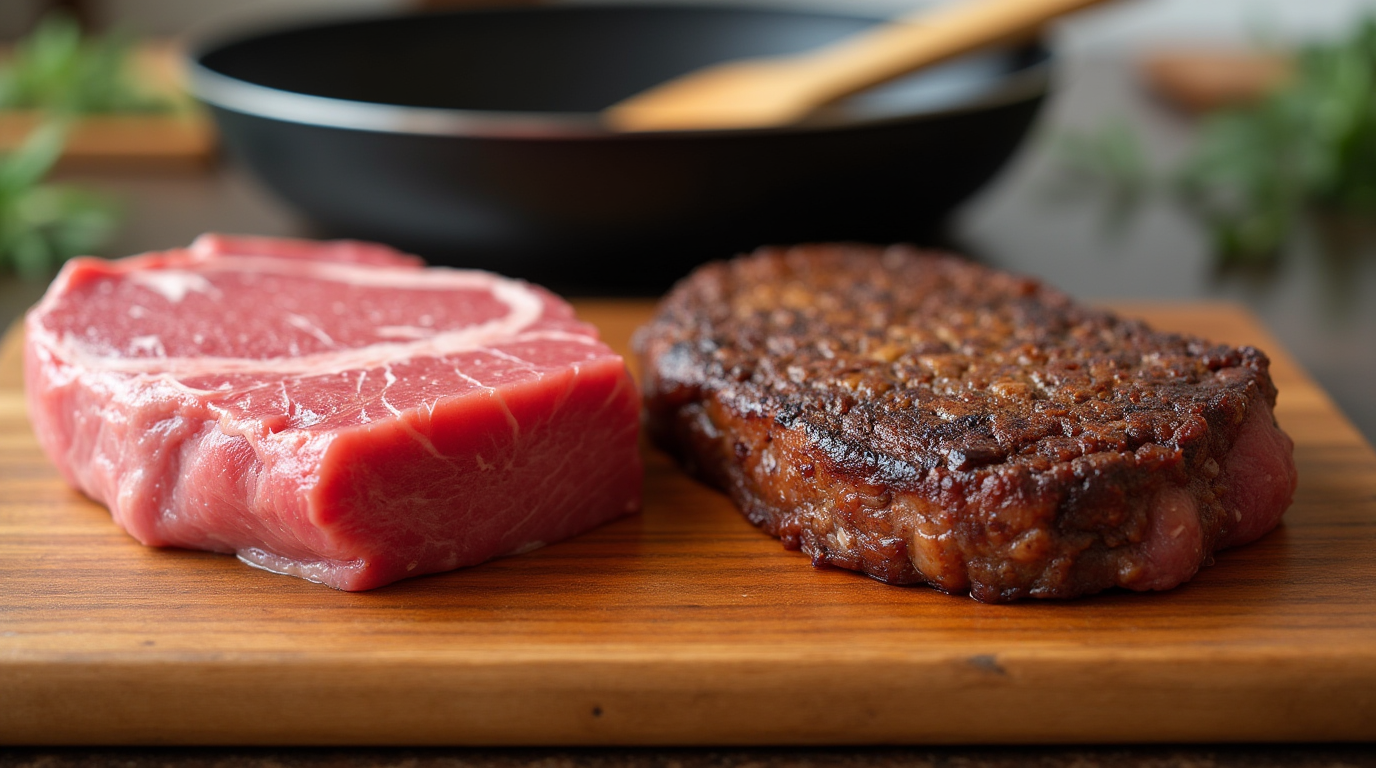When preparing a hearty meal, especially one that involves slow cooking, the question often arises: What Happens if You Don’t Brown Meat Before Slow Cooking? This topic is crucial for both novice and experienced cooks aiming to achieve the best flavors and textures in their dishes.
In this comprehensive guide, we will delve into the effects of not browning meat in a slow cooker, explore the nutritional comparison of lamb and beef, and provide actionable tips to enhance your slow-cooked meals.
For more ideas on festive dishes, check out Popular Meat for Christmas Dinner to inspire your next holiday feast.
Understanding the Process of Browning Meat
What Does Browning Meat Involve?
Browning meat is a cooking technique that involves searing the surface of the meat at high temperatures until it develops a rich, brown crust.
Typically, this is done in a hot skillet or frying pan with a small amount of oil or fat. Browning meat before slow cooker meals not only enhances the appearance of the dish but also significantly impacts its flavor and texture.
Why Browning Enhances Flavor and Texture?
Moreover, browning meat creates a caramelized exterior that locks in juices, ensuring the meat remains tender and succulent during the slow cooking process.
Additionally, the browned bits left in the pan, known as fond, can be deglazed with liquid to incorporate even more flavor into the dish. Therefore, browning not only enhances the taste but also improves the overall texture of the slow-cooked meal.
What Happens When You Skip Browning Meat?
Impact on Flavor Development
Skipping the browning step can lead to a noticeable difference in the final flavor of your slow-cooked dish. Effects of not browning meat in a slow cooker include a less robust and nuanced taste profile.
Without the Maillard Reaction, the meat may lack the deep, savory flavors that browning imparts, resulting in a blander meal.
Texture Differences in Slow-Cooked Meat
Furthermore, meat that hasn’t been browned tends to be less tender. The searing process helps to create a barrier that locks in moisture, ensuring the meat remains juicy throughout the slow cooking process.
Consequently, skipping browning can lead to drier, tougher meat that doesn’t offer the same melt-in-your-mouth experience.
Changes in Appearance and Presentation
Additionally, the visual appeal of your dish suffers without browned meat. The golden-brown crust adds a mouthwatering appearance that can make the meal more appetizing.
Without this step, the meat may appear pale and uninviting, potentially diminishing the overall presentation of your slow-cooked dish.
Pros and Cons of Browning Meat Before Slow Cooking
Advantages of Browning Meat
Browning meat before slow cooking offers several advantages. Firstly, it enhances the flavor through the Maillard Reaction, providing a richer taste profile.
Additionally, it improves the texture by keeping the meat tender and juicy. Moreover, the browned bits from the pan can be incorporated into the dish, adding depth and complexity to the overall flavor.
Situations Where Browning May Not Be Necessary
However, there are scenarios where browning meat before slow cooking might not be necessary. For example, in recipes that already include ample seasoning, marinades, or flavorful liquids, the absence of browned meat may be less noticeable.
Furthermore, for those with limited time or kitchen equipment, skipping the browning step can simplify the cooking process without drastically compromising the meal’s quality.
Is Browning Worth the Extra Effort?
Ultimately, whether browning meat is worth the extra effort depends on your culinary goals and the specific recipe. While it adds time and requires additional steps, the enhanced flavor and texture often make it a worthwhile investment.
Conversely, if you’re prioritizing convenience or working with a recipe that doesn’t rely heavily on browned meat, you might opt to skip this step without significant drawbacks.
Step-by-Step Guide to Browning Meat for Slow Cooking
Choosing the Right Meat Cuts
Firstly, selecting the appropriate cut of meat is essential for successful browning. Cuts like chuck roast, short ribs, and stew meat are ideal for slow cooking and benefit greatly from the browning process.
These cuts have the right amount of fat and connective tissue that break down during slow cooking, resulting in tender and flavorful dishes.
Tools and Equipment for Effective Browning
Secondly, having the right tools can make the browning process more efficient. A heavy-bottomed skillet or cast-iron pan ensures even heat distribution, preventing uneven browning.
Additionally, using tongs or a spatula helps to turn the meat without piercing it, maintaining its juices and integrity.
Tips for Avoiding Common Browning Mistakes
Moreover, to achieve the best results, it’s crucial to avoid common browning mistakes. Ensure the meat is patted dry before searing to prevent steaming rather than browning. Also, avoid overcrowding the pan, as this can lower the temperature and hinder the browning process. Finally, allowing the meat to sear undisturbed for a few minutes before flipping ensures a proper crust forms.
When to Skip Browning Meat
Time-Saving Scenarios
In some cases, slow cooking meat without searing can be a practical choice, especially when you’re short on time. Skipping the browning step can reduce overall cooking time, making it easier to prepare meals during busy weekdays.
Additionally, for meals where the meat will be blended or shredded, the absence of a browned crust may not significantly impact the dish’s final flavor.
Recipes Where Browning Isn’t Critical
Furthermore, certain recipes inherently possess strong flavors that don’t rely heavily on browned meat.
Dishes like pulled pork or shredded beef tacos can still be delicious without the browning step, as the slow cooking process infuses the meat with spices and liquids that compensate for the lack of searing.
Alternatives to Browning for Busy Cooks
Alternatively, busy cooks can explore alternatives to traditional browning methods. Using an oven to roast the meat before slow cooking can streamline the process, or opting for high-quality pre-seasoned or marinated meats can enhance flavor without the need for additional searing.
How to Enhance Flavor Without Browning
Using Seasoning and Marinades
If you decide to skip browning meat, you can still achieve flavorful dishes by using robust seasonings and marinades. Marinades that include acidic components like vinegar or citrus juice can help tenderize the meat and infuse it with deep flavors during the slow cooking process.
Additionally, spices and herbs can compensate for the lack of a browned crust, ensuring your meal remains delicious and aromatic.
Adding Flavorful Liquids and Aromatics
Moreover, incorporating flavorful liquids and aromatics into your slow cooker can significantly enhance the taste of your meat.
Ingredients like beef broth, wine, garlic, onions, and tomatoes contribute to a rich and savory base that infuses the meat with complementary flavors.
Consequently, these additions help create a well-rounded and satisfying dish even without the initial browning step.
Layering Ingredients Strategically
Additionally, strategically layering ingredients in your slow cooker can boost the overall flavor profile of your meal.
Placing herbs, spices, and vegetables around and on top of the meat allows for even distribution of flavors throughout the cooking process. Furthermore, adding ingredients at different stages can ensure that each component retains its unique taste and texture, resulting in a more dynamic and enjoyable meal.
Comparing Browning vs. Not Browning Meat
Side-by-Side Taste and Texture Test
To truly understand the impact of browning meat, conducting a side-by-side taste and texture test can be insightful. Prepare two identical slow cooker recipes, one with browned meat and one without.
Compare the differences in flavor, tenderness, and overall satisfaction to determine whether the additional step of browning is essential for your cooking preferences.
Nutritional Differences Between Both Methods
Furthermore, the method of preparing meat can influence its nutritional content. Browning meat often requires the use of additional fats or oils, which can slightly increase the calorie and fat content of the dish.
Conversely, skipping browning may result in a leaner meal, though this is generally marginal.
Additionally, the Maillard Reaction during browning can create new flavor compounds, but it doesn’t significantly alter the overall nutritional profile of the meat.
Visual Appeal: Does It Matter?
Lastly, visual appeal plays a role in the dining experience. Does browning meat matter for slow cooking? In many cases, the presentation of browned meat adds an appetizing look to the dish, making it more appealing to diners.
However, for meals where the meat is mixed with other ingredients or served in a dish like stew, the absence of a browned exterior may be less noticeable.
Recipes and Examples of Browning vs. Not Browning
Classic Pot Roast with and Without Browning
With Browning:
- Ingredients:
- 3 lbs beef chuck roast
- Salt and pepper to taste
- 2 tablespoons vegetable oil
- 4 carrots, peeled and cut into chunks
- 3 potatoes, peeled and quartered
- 1 onion, sliced
- 4 cups beef broth
- 2 cloves garlic, minced
- 2 tablespoons tomato paste
- Directions:
- First, season the beef roast with salt and pepper.
- Next, heat the vegetable oil in a large skillet over medium-high heat.
- Then, brown the roast on all sides until a deep brown crust forms.
- After that, transfer the roast to a slow cooker.
- Subsequently, add the carrots, potatoes, and onions around the meat.
- Additionally, mix the beef broth, garlic, and tomato paste, then pour over the roast.
- Finally, cook on low for 8-10 hours or until the meat is tender.
Without Browning:
- Ingredients:
- 3 lbs beef chuck roast
- Salt and pepper to taste
- 4 carrots, peeled and cut into chunks
- 3 potatoes, peeled and quartered
- 1 onion, sliced
- 4 cups beef broth
- 2 cloves garlic, minced
- 2 tablespoons tomato paste
- Directions:
- First, season the beef roast with salt and pepper.
- Next, place the roast directly into the slow cooker.
- Then, add the carrots, potatoes, and onions around the meat.
- After that, mix the beef broth, garlic, and tomato paste, then pour over the roast.
- Finally, cook on low for 8-10 hours or until the meat is tender.
Comparison:
- With Browning: The roast has a richer flavor and a more appealing color. The meat remains juicier and more tender.
- Without Browning: The roast is still flavorful but may lack the depth that browning provides. The texture might be slightly less tender and moist.

Beef Stew: A Flavor Comparison
With Browning:
- Ingredients:
- 2 lbs beef stew meat, cubed
- Salt and pepper to taste
- 3 tablespoons flour
- 2 tablespoons vegetable oil
- 1 onion, chopped
- 3 cloves garlic, minced
- 4 cups beef broth
- 2 cups diced tomatoes
- 4 carrots, sliced
- 3 potatoes, cubed
- 2 teaspoons thyme
- 1 teaspoon rosemary
- Directions:
- First, season and coat the beef with flour.
- Next, heat oil in a skillet and brown the beef on all sides.
- Then, transfer the beef to a slow cooker.
- After that, add the onion, garlic, beef broth, and diced tomatoes.
- Subsequently, include the carrots, potatoes, thyme, and rosemary.
- Finally, cook on low for 7-8 hours until the beef is tender.
Without Browning:
- Ingredients:
- 2 lbs beef stew meat, cubed
- Salt and pepper to taste
- 3 tablespoons flour
- 1 onion, chopped
- 3 cloves garlic, minced
- 4 cups beef broth
- 2 cups diced tomatoes
- 4 carrots, sliced
- 3 potatoes, cubed
- 2 teaspoons thyme
- 1 teaspoon rosemary
- Directions:
- First, season and coat the beef with flour.
- Next, place the beef directly into the slow cooker.
- Then, add the onion, garlic, beef broth, and diced tomatoes.
- After that, include the carrots, potatoes, thyme, and rosemary.
- Finally, cook on low for 7-8 hours until the beef is tender.
Comparison:
- With Browning: The stew has a deeper, more complex flavor and a richer color. The beef remains tender and infused with enhanced flavors from the seared exterior.
- Without Browning: The stew is still hearty and delicious but may have a milder flavor profile. The texture of the beef is still tender, but it might lack the savory depth achieved through browning.

Chicken Slow-Cooker Recipes Without Browning
Simple Chicken Stew Without Browning:
- Ingredients:
- 4 boneless, skinless chicken thighs
- Salt and pepper to taste
- 1 onion, sliced
- 3 cloves garlic, minced
- 4 cups chicken broth
- 2 cups sliced mushrooms
- 3 carrots, chopped
- 2 potatoes, cubed
- 1 teaspoon thyme
- 1 teaspoon rosemary
- Directions:
- First, season the chicken thighs with salt and pepper.
- Next, place the chicken directly into the slow cooker.
- Then, add the onion, garlic, chicken broth, mushrooms, carrots, potatoes, thyme, and rosemary.
- After that, stir to combine all ingredients.
- Finally, cook on low for 6-7 hours until the chicken is tender and the vegetables are cooked through.
Comparison:
- Without Browning: The chicken stew remains flavorful and tender, benefiting from the slow infusion of spices and vegetables. While it lacks the caramelized flavor that browning provides, it still offers a comforting and satisfying meal.

Frequently Asked Questions About Browning Meat
Does browning meat affect its tenderness in slow cooking?
Yes, browning meat can affect its tenderness. The searing process helps to lock in juices, ensuring that the meat remains moist and tender during slow cooking. Without browning, the meat may lose more moisture, potentially resulting in a drier texture.
Is it safe to skip browning meat before slow cooking?
Absolutely. It is entirely safe to skip browning meat before slow cooking. While browning enhances flavor and texture, the slow cooking process itself thoroughly cooks the meat, ensuring it is safe to eat.
What oils or fats are best for browning meat?
Using oils with high smoke points, such as vegetable oil, canola oil, or grapeseed oil, is best for browning meat.
These oils can withstand high temperatures without burning, allowing for effective searing.
Final Thoughts
Deciding whether to brown meat before slow cooking involves weighing the benefits of enhanced flavor and texture against the convenience of skipping an extra step.
By conducting a nutritional comparison of lamb and beef, and understanding the effects of not browning meat in a slow cooker, you can make informed choices that align with your health goals and cooking preferences.
Whether you prefer the rich flavors brought by browning or the simplicity of slow cooking meat without searing, both methods can yield delicious and satisfying meals. Embrace the flexibility of slow cooking, experiment with different techniques, and enjoy the hearty results of your culinary efforts.

